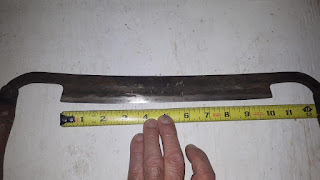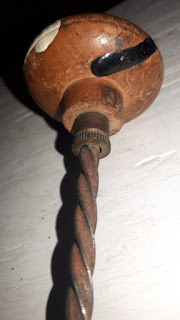Continuing in my series:
A few small tools
Wood Chisel
That little chisel spoke to me from a distance, its overall shape was saying, I'm Swedish.
Swedish chisels (and scrapers and saws plate and etc) are prized for their steel.
There are various steels around the world named from their origins: Sheffield England, Soligen Germany etc, the differences being in the alloy and the quality of the iron ore used.
Fun fact Sheffield England steel contain Swedish iron ore.
The resulting steel properties are what make the difference in how sharp and edge you can raise and how tough and resilient that edge would be. Too soft it sharpen fast but does not keep a sharp edge long. To hard, hard to sharpen and edge break easily. It is a balancing act.
Swedish chisels have a well deserved reputation for being excellent performer in that regard.
some rust spot mostly where stamped
Bit of a label left
but unable to read much??
1/4 inch chisel
about 8-1/2 in long
ESTEEL SWEEDEN
all cleaned up.
The edge, as found is sharp, it cuts.
Oh, need a good touch up to bring it up to my standards but well care for that one
Archidemes, Archimedean drill, Double spiral drill, Jeweler drill, Push drill
All these names described essentially the same tool.
They all have a double twist spiral on a central shaft. Pushing down/up a bobbin or a side handle cause the drilling implement to rotate CW on the down push and CCW on the return pull.
They came in various forms, some with some sort of weight to give it spinning momentum.
Some variations of the tool
Notice the early spear head bits
Pic from Dictionary of woodworking tools by RA Salaman
The smallest ones, never had them, flywheel or side handle. These would be the jeweler types, such as I found.
From Top to Bottom
Craftsman (Millers-Falls) push drill, fully enclosed mechanism
The one I found, now cleaned up. Driven by the bobbin.
My previous jeweler drill, a miniature push drill
The driving bobbin is simply kerf in each corner (metal insert) to let the rod twist
when bobbin is pushed down or reverse when pull up.
The indent in the bobbin would allow the use of a small bow to drive it.
Incidentally the Bow drill is considered one of the more ancient drilling tool,
the pump drill coming after.
The rod at the top is secured by a screw in nut cover which thread over the captive metal threaded receptacle
Taken apart, notice the nice pointy and shiny end to the rod
That crimp ring retain the nut captive
As far as the nut will go.
The pointy end serve as a friction bearing, just metal on metal contact,
hence why so shiny :-)
Put in a dab of grease on reassembly.
The business end has a small mandrel
which seems to be lead soldered to the shaft (?)
The jaw fully close
De-rusted, cleaned, lubricated, works like a charm ??
Hold on, they can be tricky to use for the un-initiated.
Let me explain.
Unlike today's drilling implement which always rotate in the same direction (FWD or REV) on some power tools, these push drills rotate one direction, then reverse direction, while you are still maintaining cutting pressure, but nothing seems to be happening fast...why??
Wrong drilling implement is the most glaring reason, they can cut pretty fast with the right dill bit, in the right material. NOT necessarily wood!!
First question is, what size bits will it take.
5/64 fits well, next size up I have is 3/32 (6/64) barely fit, tight, not forcing it.
Too small to take my 5/64 push drills Z bits
Because the cutting action can happens in both directions (FWD & REV) a normal twist metal drill such as I have chucked in, is not very efficient. Ever try to drill with your power drill in reverse? Not very good is it ?? :-)
Some of the original drill bits would had been spear head,
This 19 century brace bit is a modified form of the ancestral spear bit
The opposite angled groove on each side, makes it cut with
more of a shearing action than a scrapping action.
This bit was marketed as a countersink bit for soft metal and iron objects,
accommodate 90 degree taper screw heads.
and later superseded by more efficient implements:
Enter the Gouge bits or the more modern Z bits especially designed for push drills.
Later Stanley would replace those and supply regular twist drill bit on a Yankee shaft.
A good indication that by then they were not the hand tool powerhouse they once were
and forgot everything they used to know about tools :-(
The differences, they both cut in both directions, as opposed to the spear bit which is more of a scrapper action. The spear bit is probably one of the most ancient drill implement.
If you only used a push drill with the ubiquitous metal twist drill bit, you have no idea how well and quickly this thing can drill.
Top, bigger hole drilled quickly with a Z bit. Had to stop before I drill through :-)
The other hole, with metal twist bit used in the bobbin driven jeweler drill, did cut, but a lot slower, and nowhere as deep with roughly the same amount of driving forces.
I would had run out of juice before I went thru that pine...
There is the Z bit secret. Two cutting edges, one for each directions.
YES, that push drill is secured in the newly restored Starrett vise, and NO I am not worry about marring or scratching it. Does not take much force to grip it securely, its a Starrett :-)
And finally in comparison, the other smaller jeweler drill.
with the same drill bit used in the bigger jeweler drill.
It barely made a scratch...
Why is that? It is not designed to drill wood but rather thin composite, plastic, metals and etc.
I used it a lot to drill my own PCBs back in the days, for which a regular twist drill is fine, and even a nail would work (acting like a spear bit). But you do not have the rotational forces nor can put on as much down pressure to it compared to the bigger jeweler drill which managed thru the wood, albeit nowhere as efficiently as the Z bit.
Of course they are limitations on how small a gouge or Z bit you can make...
One last thing, do not confuse these double spiral drills with the more common Yankeee Automatic screwdrivers. They both works similarly, pushing down cause rotation, except a screwdriver does not rotate on the up stroke, otherwise you will be screwing and unscrewing. You have to reverse a mechanism to unscrew. Biggest tell tale are the spirals on both tools. Henceforth not all bits found to fit your spiral drill are drilling implements.
STANLEY Surform blade
One of the most exciting for me was perhaps, the less expensive of the pieces I picked up.
How old is it? We have a few clues on the package
Pat No shown is
2769225 awarded Nov 1956.
That Patent makes it just about as old as I am :-)
Well preserved for its age, just like me :-)
Was Robert Simpson, Simpson, Simpson-Sears, Sears Canada.
The price Cdn $1.70 sounds like late 60s
That one is staying put inside its cellophane wrapper, as is :-)
Bob, running out of rusty implements?? Have no fear !! :-)









































































